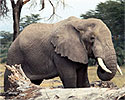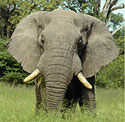Neuroscience For Kids
Elephants Use Sight and Smell to Know Friend From Foe
 December 2, 2007
December 2, 2007
It is important to know your friends from your enemies. It's easy for us to do, but can other animals do the same? Elephants can! They use their sense of vision and smell to tell the difference between people who pose a threat and those who do not.
In Kenya, researchers found that elephants react differently to
clothing worn by men of the Maasai and Kamba ethnic groups. Young Maasai
men spear elephants and pose a threat to elephants; Kamba men are mainly
farmers and are not a danger to elephants.
When the elephants detected the smell of clothing worn by a Maasai man,
they moved away from the smell faster, traveled further from the smell,
and took longer to relax than when they detected the smells of either
clothing worn by Kamba men or clothing that was not worn at all. The
elephants also always moved to tall grass after smelling Maasai-worn
clothing, something they rarely did when they smelled Kamba-worn clothing.
Maasai men typically wear RED clothing. When the
elephants saw RED, unworn clothing, they reacted
differently. Rather, than running away, the elephants acted aggressively
toward the red clothing.
The researchers interpret these results to differences in the emotional reaction of the elephants to the smells and sights. Smelling a potential danger means that a threat is nearby and the best thing to do is run away and hide. Seeing a potential threat without its smell means that risk is low -- perhaps a Maasai man was in the area, but has left. Therefore, instead of fear, the elephants show aggression.
Elephant Facts:

- An elephant brain weighs approximately 6,000 grams (13 pounds).
- Elephants have a hearing range between 1 and 20,000 Hz. The very low frequency sounds are in the "infrasound" range. Humans cannot hear sounds in the infrasound range.
- African elephants sleep only 3.3 hours each day. Asian elephants sleep only 3.9 hours each day.
- The total surface area of the African elephant cerebral cortex is 6,300 square cm. The surface area of the human cerebral cortex is 2,500 square cm.
- The facial nerve in elephants is 5.2 times larger than that in humans. The elephant facial nerve and part of the trigeminal nerve unite to form the great proboscideal nerve that controls the elephant's trunk.
(Fact references: Nieuwenhuys, R., Ten Donkelaar, H.J. and Nicholson, C., The Central Nervous System of Vertebrates, Vol. 3, Berlin: Springer, 1998; Peters, A. and Jones, E.G., Cerebral Cortex, New York: Plenum Press, 1984; Shoshani et al., Elephant brain. Part I: Gross morphology functions, comparative anatomy, and evolution, Brain Res. Bulletin, 70:124-157, 2006.)
References and more information:
- Bates, L.A., Sayialel, K.N., Njiraini, N.W., Moss, C.J., Poole, J.H. and Byrne, R.W., Elephants classify human ethnic groups by odor and garment color, Curr. Biol., 17:1938-1942, 2007.
- Amazing Animal Senses - Neuroscience for Kids
Copyright © 1996-2007, Eric H. Chudler, University of Washington
